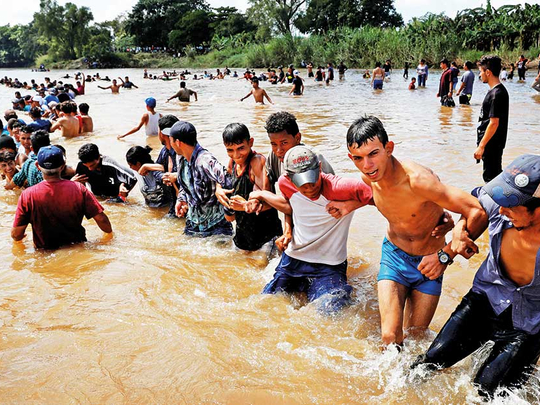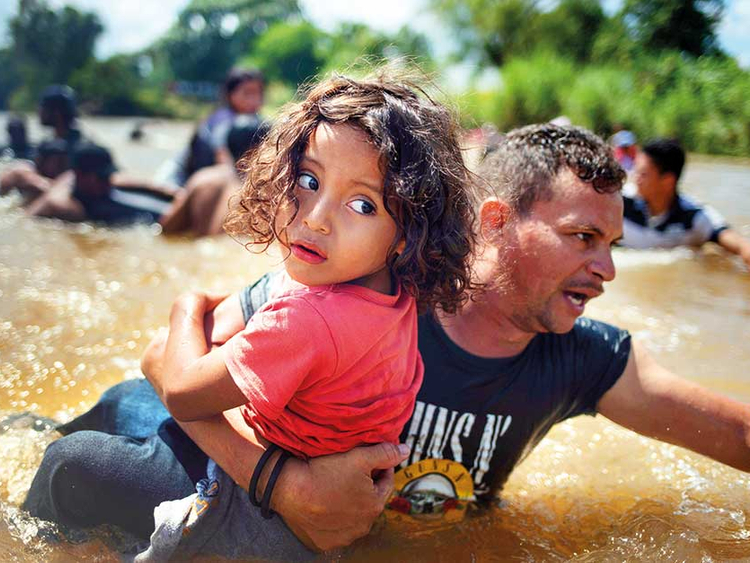
WASHINGTON: The Trump administration ordered 5,200 additional troops to the Southwest border on Monday, more than doubling the military presence there and widening the Pentagon’s role in domestic policing operations.
The move is in response to a caravan of Central American migrants who may seek to enter the United States through Mexico, officials said. President Trump has characterised the group as an “invasion” and falsely claimed it included terrorists and was organised by Democrats handing out money, despite denials by national security experts.
Trump’s critics dismissed the unusually heavy deployment of military troops to assist in border protection as a political ploy by the administration to appeal to its base ahead of the November 6 midterm election.
The armed troops will help the Border Patrol “harden points of entry and address key gaps around points of entry” to keep members of the caravan from crossing the border, General Terrence O’Shaughnessy, head of the US Northern Command, said at a news conference with the Border Patrol.
The rapid timetable of the operation would have the 5,200 troops in place by the end of the week. The caravan of approximately 3,500 migrants is still moving through southern Mexico, about 900 miles from the US border, and is steadily declining in numbers.
Trump has seized on the immigration issue ahead of next week’s midterm election, even though illegal immigration this year is on pace to be lower than in all but four of the previous 45 years.
The president has tweeted repeatedly about the threat posed by the caravan, a characterisation that may have played a role in Saturday’s deadly synagogue attack in Pittsburgh. In online postings, the purported shooter, Robert Bowers, accused Jewish groups of aiding “invaders” by helping immigrants and refugees settle in the United States.
Though Pentagon officials in the past have emphasised that the military was playing only a supporting role in assisting civilian authorities along the border, O’Shaughnessy portrayed the military as taking a far more active operational role.
“As we sit here today, we have about 800 soldiers that are on their way right now. They’re coming from Ft Campbell. They’re coming from Ft Knox. They’re moving closer to the border” and are “ready to be employed on the border.”
The first wave of 800 troops will be followed in coming days by additional deployments in Arizona and California. They will include active-duty military personnel from three combat engineering battalions and three helicopter units.
About 2,000 National Guard troops are already assisting at the border under a previous Pentagon operation. Among other roles, Black Hawk helicopters equipped with night sensors will be available to ferry Border Patrol personnel “exactly where they need to be” to “spot groups” and “to fast-rope down” to intercept migrants trying to cross the border. Military aircraft will conduct surveillance.
The Pentagon is also sending engineers who could build vehicle barriers, walls and razor-wire fencing around the entry points. Soldiers arriving at the border were bringing 22 miles of concertina wire and would have another 150 miles available, O’Shaughnessy said.
The Pentagon is sending riot gear, ready-to-eat meals and tents to equip, feed and house additional Border Patrol agents sent to the border. In addition, the Pentagon is sending four larger transport planes, including three C-130s and a C-17 to ferry the agency personnel to spots along the border where migrants may seek to cross illegally, officials said.
Customs and Border Protection Commissioner Kevin McAleenan said that the agency is tracking two large groups of between 3,000 and 3,500 migrants each in southern Mexico. He said the groups were preparing to enter the United States within the next few weeks.
The Pentagon and the Border Patrol are focusing initially on building up security measures at points of entry across the border, McAleenan said.
If the migrants seek to cross the border at more remote locations, the Border Patrol has an additional 830 agents to move to those locations with military assistance, he said. The agency also has two dozen of its aircraft patrolling the Southwest border, he added.
Asked why so many troops were needed, McAleenan said migrant groups that had crossed the Guatemalan-Mexico border had recently used “violent tactics” to overwhelm border guards who attempted to block them.
Trump and Homeland Security Secretary Kirstjen Nielsen have vowed to stop the caravan, but it’s been unclear whether the Border Patrol would be able to cope, given an influx of asylum-seeking families this year that recently accelerated.
“As the president and Secretary Nielsen have made clear, we will not allow a large group to enter the United States in an unsafe and unlawful manner,” McAleenan told reporters.
In recent days, the Border Patrol had deployed 100 “special response team operators” to prepare plans to beef up security at each of the 26 points of entry along the border, he said. An additional 1,000 officers, including 250 with training in riot control, are ready to move to the border as well, he said.
But the agency sought assistance from the Pentagon “due to the large size of the potential caravans that may arrive,” McAleenan said.
The Pentagon deployment — up from an original estimate of 800 that officials said was likely last week — would be double the 2,500 US troops in Syria. Critics called the operation a politically motivated misuse of American military.













